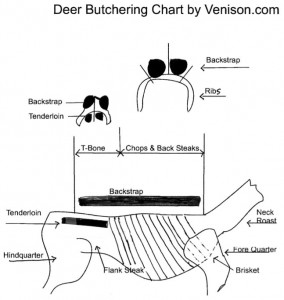Field & Final Dressing
Best Advice: For best deer meat, field dress the deer immediately upon harvesting.
Minimum equipment: 7” sharp knife with serrated tip. Tub of moist hand wipes.
Nice to have: Latex or vinyl gloves. Rope & pulleys. Strong tree limb.
The easiest field dressing is to hang the deer by the hind legs, splayed wide. But more important is to get the job done soon, so, on the ground is fine.
Important Current Information: Read up on the latest news and information on Chronic Wasting Disease and you’ll be safe in your harvesting and eating.
Don’t mess up the meat. If you are hunting for meat, shoot your animal in the head, neck or shoulder without a lengthy chase or no chase at all.
A shoulder shot is the safest and best bet because it is a large area and hits the heart or lungs and avoids damage to the rest of the organ area, especially the stomach and intestines. This is a good shot, too, if you want a trophy mount.
He be Dead! Be sure your deer is dead before approaching to field dress him. If in doubt, shoot him again. Let this be your guide: It is sure an embarrassing story to be injured by a dead deer.
Bleed out:
Cut and drain the aorta: At the base of the deer’s throat, with your finger, feel for the breast bone. (To practice, feel at the base of your own throat for the V. In the deer, it will be an inverted C shape, an arched bone.) Insert a long sterile knife just above the bone into that spot and make a 3” stroke, across the throat. You know if you have cut the aorta because the blood will gush. (If you made a heart or lung shot, your animal may already be bled out, but just assume it’s not bled out and cut the aorta till you get some show of blood.) It’s ideal to have hind feet in the air, but it is more important to bleed out quickly. (The blood will go inside the cavity or outside. That doesn’t matter because you will pour it out later.)
[In commercial operations in the field (with non-native species), knives are kept in a shallow Tupperware container with a mat of cloth or paper towel and ½ “ or so of isopropyl alcohol to sanitize.
[Commercially, after initial bleeding out, the deer is ‘zapped’ by attaching clips to one ear and the opposite hind leg and ‘electrocuting’ it several times from a charger. The deer will flex and relax with each charge and this squeezes out blood from tissues. The theory is that this tenderizes the deer and also makes it easier to butcher. If you try this at home, shout “clear” before the charge so nobody is holding on to the deer and gets ‘zapped,’ too!]
Remove Scent Glands:
Look for scent glands below the “knees” on the hind legs. These will be dark, bulgy areas. Cut them out and throw away. Far away. Change gloves or wash hands (moist wipes OK) before going back to the carcass.
Open the skin:
Using the bleed-out hole or cutting a new hole near the anus, cut only the skin from the throat to the anus length-wise up or down the belly of the deer. You can lift up the skin, pinching it between your fingers, to get your bearings or initiate your cut.
Open the cavity:
The meat thickness over the stomach varies from thin lower down to thicker on the chest. The variance is usually 1-2 inches. Cut open the deer along the skin-cut-line to open to the cavity. Use the serrated knife edge to cut/saw the chest bones. Cut beside the sternum. The cavity will have all the organs neatly packed inside. Your goal is to keep all the organs intact and remove them from inside the cavity.
Removing the Organs:
Feel around the group of organs and identify the tissues holding them in the cavity. At the top, you’ll find a couple of tissues securing the lungs to the rib cage. Cut them next to the rib cage.
Grasp and cut the trachea (tube to stomach) and aortas (blood vessels) as far up the neck as you can reach. Work your way around the organs cutting what secures them inside the deer, scooping the organs out of the cavity as you go.
At the rear end, depending on male or female, things will work a little differently. Primarily, you want to cut around the rear orifices (openings) from the outside leaving the canals to those orifices intact. That way, the whole irrigation and reproduction systems will come out with the other organs.
Cut around the male testicles, leaving them attached to the organs. If the deer is hanging, the organs will fall out with gravity. If you are working on the ground, simply scoop them out.
After removing the organs, retrieve any primary organs you want to save, such as the liver. Again, check latest news about CWD to see what is safe to eat. If you cut into any offal stuff, be sure to wash out the deer before hanging it to age.
Hang and Age the deer:
Hang the deer upside down by its legs with its hind legs splayed out wide and with the cavity wide open to the air. Some people like to skin their deer before aging. This speeds the cool down of the meat. Other people leave the hide on to age their deer.
Temperatures can range from 36-45 degrees F, the cooler the better. The carcass can even freeze at night and thaw during the day. A week is a good period to age the deer.
- Netting can be used over the carcass.
- Be sure the carcass is out of reach of predators.
[Note about Elk: Elk carcasses are more temperamental to age outdoors and spoil easier than a whitetail or mule deer. Definitely remove the hide before aging and cool near freezing.]
Removing the hide:
Remove the hide before or after the deer has been aged. On the internet there are a million theories on how to remove the hide easily. There’s even a ‘YouTube’ clip with the hide being pulled off with a truck. Hmm, maybe the truck exhaust adds a nice flavor to the meat.
It may be easiest to cut the hide off while the deer is hanging. It is also easy to do on a table. Mostly, you just want to take a sharp knife and gently pull the hide away from the meat and cut the connecting film.
Cut a circle around the neck like a necklace or cape. Cut a circle around the lower shank and straight up the leg.
Pretend you are a sculptor. Take your time and you’ll be safe as well as have a nice hide to cure.


